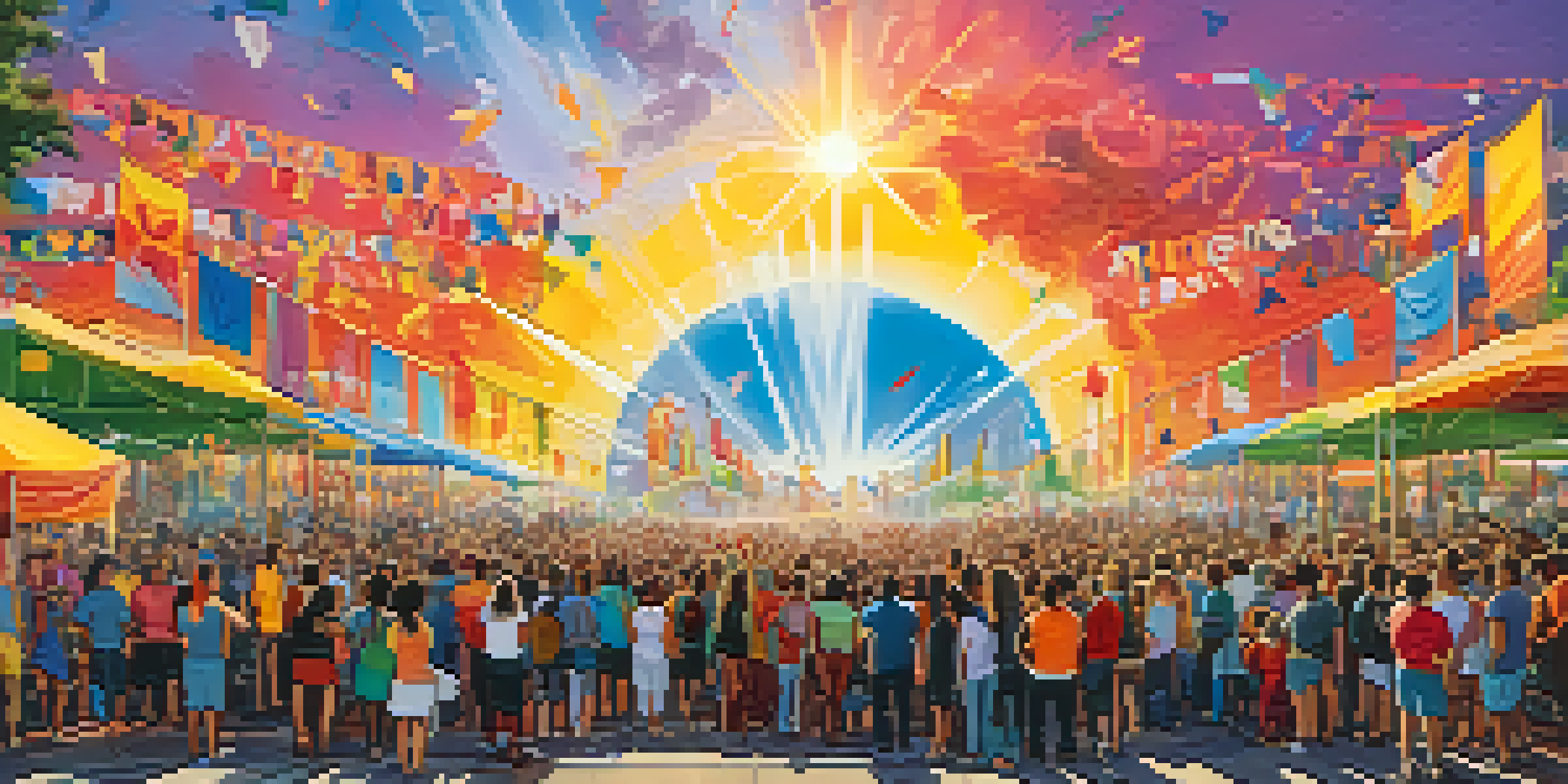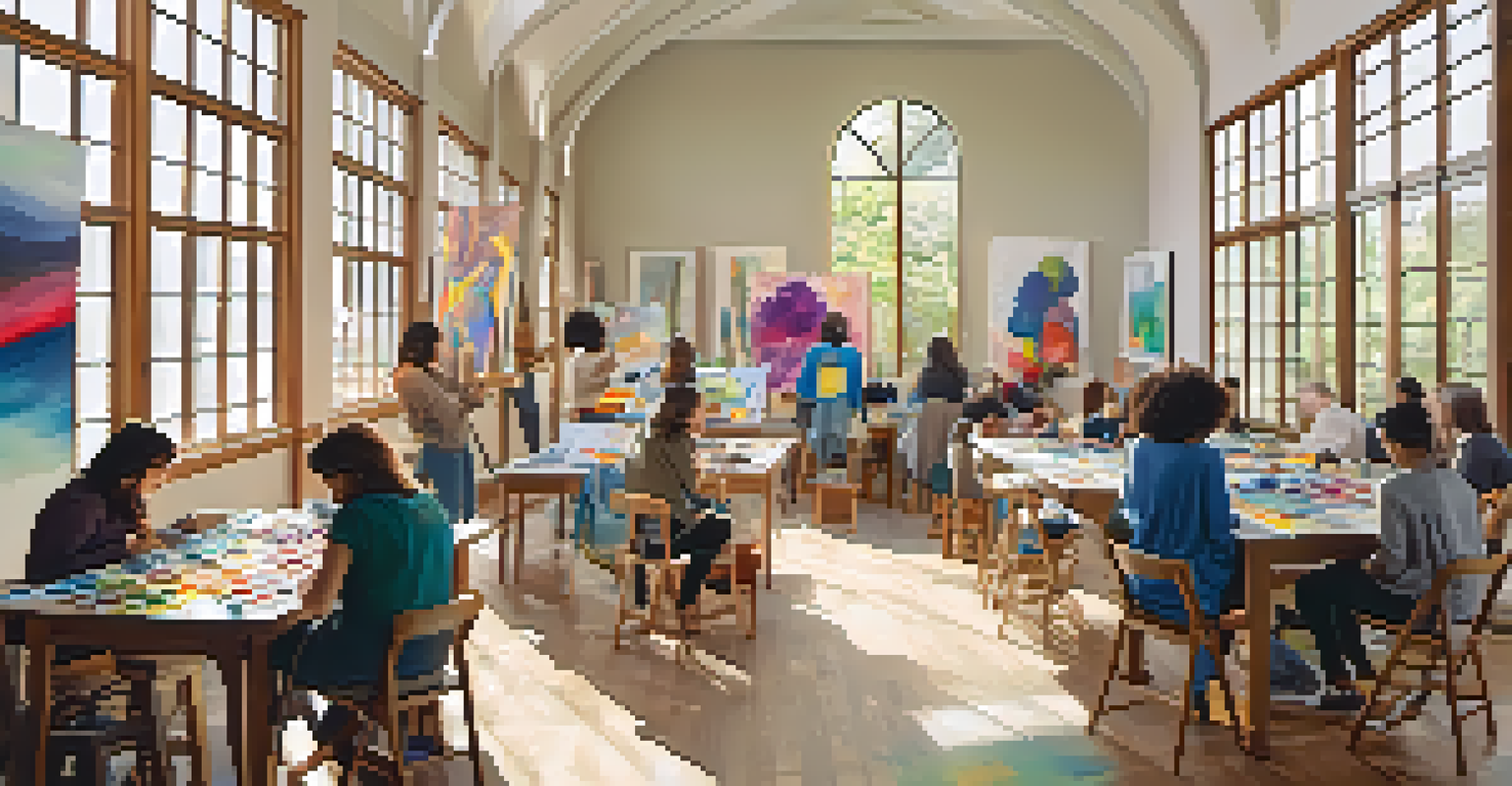Art Collectives: A Catalyst for Community Engagement

Understanding Art Collectives and Their Purpose
Art collectives are groups of artists who collaborate to create and promote art. They often share resources, ideas, and space, making art more accessible and inclusive. By coming together, these artists amplify their voices and reach broader audiences, fostering a sense of community.
Art is not what you see, but what you make others see.
These collectives can take many forms, from informal gatherings to structured organizations. The key is collaboration; artists work together, often blending their unique styles and perspectives. This not only enriches their creativity but also invites dialogue and connection among diverse community members.
In essence, art collectives serve as a platform where artists can express their visions while engaging the community. They encourage participation, spark conversations, and can even drive social change, making them vital for cultural and civic life.
The Role of Art Collectives in Community Building
Art collectives play a pivotal role in nurturing community ties. By hosting events, exhibitions, and workshops, they create opportunities for residents to come together. These activities not only showcase local talent but also foster a sense of belonging and pride in the community.

Moreover, art collectives often focus on themes relevant to their neighborhoods, addressing issues like social justice, identity, and cultural heritage. This relevance helps to engage residents who may not typically participate in the arts. They transform public spaces into vibrant areas of creativity and discussion, inviting everyone to join in.
Art Collectives Foster Community
Art collectives create inclusive spaces that connect artists and residents, promoting creativity and community engagement.
Through these interactions, art collectives build networks of support among artists and community members. This collaborative spirit strengthens relationships, making the community more resilient and connected, especially during challenging times.
Creating Inclusive Spaces for Diverse Voices
One of the most significant contributions of art collectives is their commitment to inclusivity. They often prioritize underrepresented voices, ensuring that diverse perspectives are heard and celebrated. This approach not only enriches the artistic landscape but also promotes empathy and understanding within the community.
The role of the artist is to make the world a better place through their art, and to inspire others to do the same.
By actively engaging marginalized groups, art collectives can help dismantle barriers that often exist in the art world. Workshops and outreach programs can empower individuals who might feel excluded, providing them with tools to express themselves creatively. This inclusivity fosters a rich tapestry of narratives and experiences that reflect the community's true essence.
Ultimately, the focus on inclusivity transforms art collectives into safe spaces for dialogue and expression. They invite everyone to contribute to the conversation, reinforcing the idea that art belongs to all and can be a powerful tool for change.
Art Collectives as Agents of Social Change
Art collectives often serve as catalysts for social change, using their platforms to address pressing issues. Through powerful visual storytelling, they can highlight injustices and inspire action, drawing attention to causes that matter to their communities. This ability to evoke emotion makes art a compelling medium for advocacy.
For example, many collectives engage in community-based projects that tackle local challenges, such as poverty, education, and environmental issues. By collaborating with other organizations and community members, they can amplify their impact and create meaningful change. Art becomes a rallying point, uniting people around shared goals.
Inclusivity Drives Artistic Dialogue
By prioritizing underrepresented voices, art collectives enrich the artistic landscape and foster empathy within the community.
In this way, art collectives are not just about creating beautiful works; they are about instigating conversations that lead to action. They remind us that art can be a powerful vehicle for transformation, challenging the status quo and inspiring hope.
The Impact of Technology on Art Collectives
In today’s digital age, technology plays a crucial role in the evolution of art collectives. Social media platforms allow artists to connect with wider audiences, share their work, and collaborate across geographical boundaries. This connectivity has transformed how art is created, promoted, and experienced.
Online galleries, virtual exhibitions, and digital workshops make art more accessible to those who may not be able to physically attend events. These innovations allow art collectives to reach diverse audiences, breaking down traditional barriers to entry. This accessibility fosters a vibrant online community where ideas and creativity flourish.
However, while technology expands reach, it’s essential for art collectives to balance online engagement with in-person connections. The magic of community often lies in face-to-face interactions, so finding that sweet spot is key to maintaining the essence of collective creativity.
Challenges Faced by Art Collectives
Despite their many benefits, art collectives face several challenges that can hinder their effectiveness. Funding is often a primary concern, as many collectives rely on grants, donations, and volunteer support. Securing stable financial resources can be difficult, especially for emerging groups.
Additionally, managing group dynamics can pose a challenge. With diverse personalities and creative visions, conflicts may arise, which can disrupt the collective's harmony and productivity. Open communication and a shared vision are essential for overcoming these hurdles and maintaining a collaborative spirit.
Technology Enhances Art Collective Reach
Digital tools allow art collectives to connect with wider audiences while maintaining the importance of in-person interactions.
Lastly, the pressure to produce commercially viable art can sometimes conflict with the collective's original mission. It’s important for art collectives to stay true to their core values while navigating the complexities of the art market and community expectations.
The Future of Art Collectives in Community Engagement
Looking ahead, the potential for art collectives to impact community engagement is vast. As more people seek connection and meaning in their lives, art collectives are poised to play a crucial role in addressing these needs. They can continue to foster creativity, inclusivity, and dialogue, making art a cornerstone of community life.
With the ongoing advancement of technology, art collectives can leverage digital tools to enhance their outreach and impact. By embracing hybrid models that combine online and offline experiences, they can engage a broader audience while maintaining the personal touch that makes their work so special.

Ultimately, the future of art collectives will depend on their ability to adapt and innovate. As they navigate the changing landscape, these collectives will remain vital in cultivating community spirit and fostering meaningful connections through the power of art.